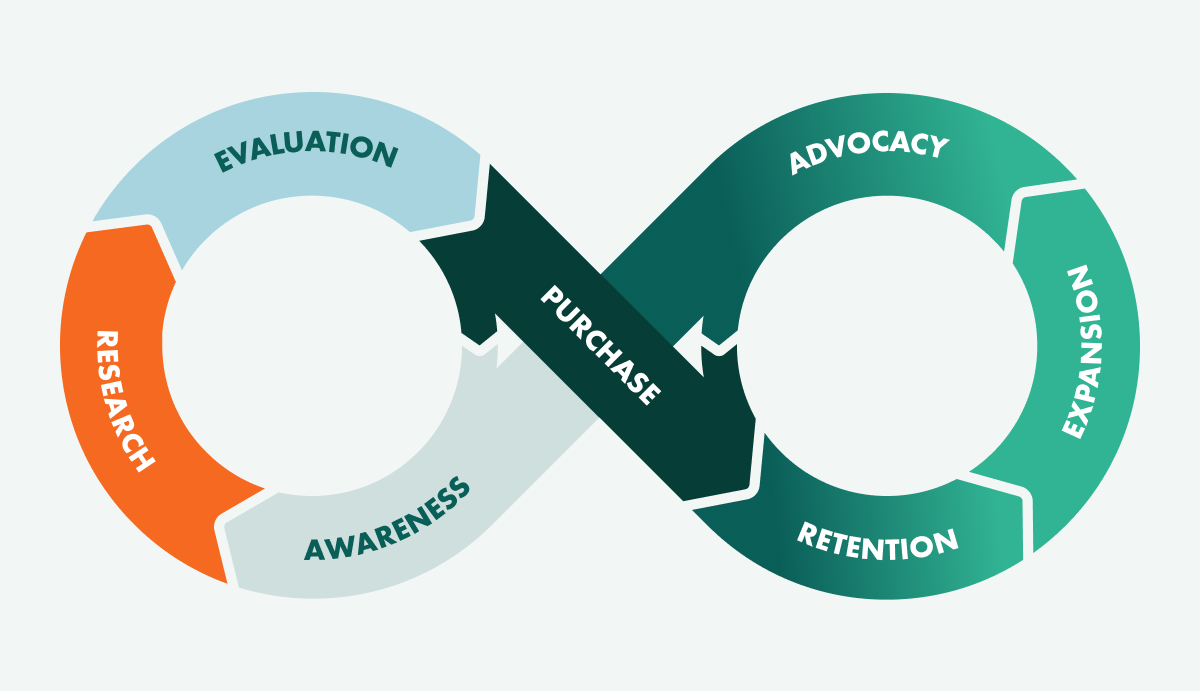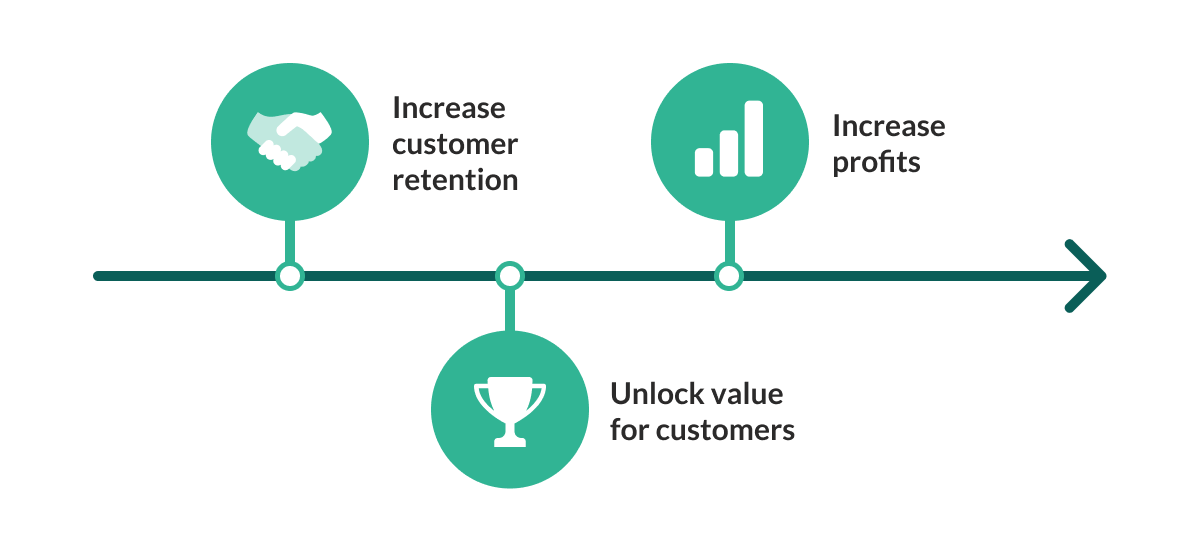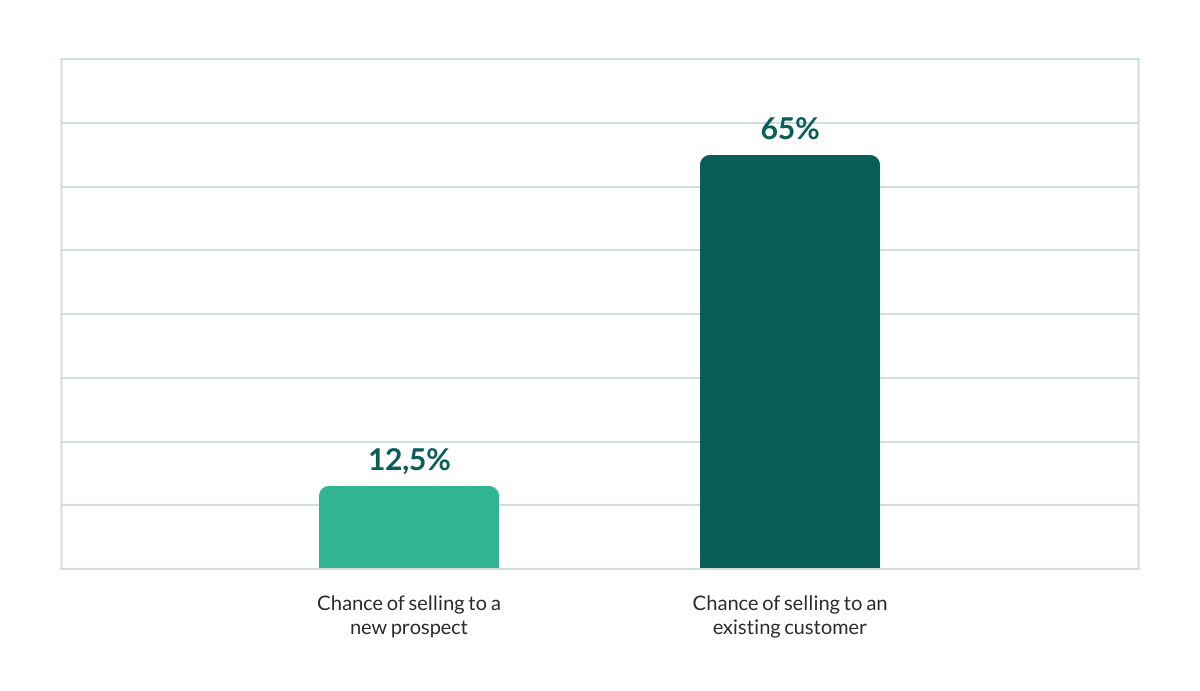It’s been almost 40 years since the idea of a customer journey was first conceived.
In the same year the first version of Microsoft Windows was released.
11 versions of Windows later, it’s fair to say the original customer journey is overdue for an update of its own.
In our minds, the update needed to retain everything that made the original great, whilst also looking to the future and representing SuperOffice’s core values.
The new version also had to help unite your marketing, sales, and customer service teams - as well as external partners - behind a common cause.
That common cause is building long-term, profitable customer relationships.
As a result, we’ve called our new concept The Relationship Loop.
We believe it can help you improve your go-to-market strategy and make significant gains in customer retention, satisfaction, and revenue.
Let us show you what we mean.
What is The Relationship Loop?
We developed the Relationship Loop as a much needed update to the customer journey.
Our emphasis on relationships stems from our mantra that relationships matter in business, and our belief that they’re key to business growth.
Using the Relationship Loop offers companies the chance to unite their marketing, sales, service, and partners, to work together to create and maintain strong customer relationships.

Leveraging the Relationship Loop model in your business will help you achieve incredible outcomes like:
- Increased lead quality and conversion rates
- Reduced levels of customer churn
- Higher customer lifetime value
- Improved customer satisfaction
- More upsell and expansion opportunities
- Developing true advocates who are passionate about your brand
- A higher rate of referrals and new business
Above all, when relationships last, revenue grows. This is the key to the Relationship Loop.
So how does it work and how can you get your customer-facing teams involved?
The Seven Phases of The Relationship Loop
The Relationship Loop can be broken down into seven specific phases which cover the entire customer lifecycle;
- Awareness
- Research
- Evaluation
- Purchase
- Retention
- Expansion
- Advocacy
Each phase is an opportunity for your marketing, sales, and service teams, as well as external partners, to collaborate and build profitable, long-term relationships with customers.
Every part of the loop is connected, and when done right, the 7 phases combine to become a self-perpetuating flywheel for growth.
To give you more insights into what the Relationship Loop can do for your business, let’s break down each of the 7 phases in more detail.
1. Awareness
As part of the awareness phase, there are five stages of awareness your prospects will go through.

Following the research phase, most prospects should be ‘Brand Aware’ and familiar with the companies who can solve their business problems.
The next step is to take the prospect from ‘Brand Aware’ to ‘Most Aware’ by helping them to get to know your brand even better.
Your marketing team can do this by nurturing your leads and providing them with timely, relevant, and valuable information that will help create a positive impression.
One of the best ways to do this is through email marketing. This uses automated email sequences dedicated to the specific problems your customers are looking to solve.
Meanwhile, your customer service team can use tools like live chat to answer initial questions your prospects may have to help foster more trust and increase awareness.
Your sales team can collaborate with your marketing team and external partners to devise content, such as webinars, that helps position your company brand as the ideal solution.
Leveraging external partners in this way helps further validate your brand by offering more information and generating social proof to help reassure prospects.
2. Research
Then comes the research phase. It’s here that prospects begin exploring solutions to their business problems.
This is very early in the buyer’s journey, they’re still focused on solving their problem rather than being ready to buy.
The research phase offers you the opportunity to recognize where the prospect is at and signal to them that you’re a trusted authority on the topic and can solve their problems.
Your marketing, sales, and customer service teams - as well as outside partners - can all work together to help achieve this.
Remember:
The customer is always at the center of this process. It's essential to put yourself in the customer’s shoes, ensuring every message resonates with their needs and pain points.
Better yet, regularly ask customers for feedback and test initiatives directly with them to make sure you're addressing their real concerns.
For the research phase, marketers should focus on creating content aimed targeting this research. This ‘top-of-funnel’ content could include things like blog posts or podcasts.
Your sales and service teams can support this content by offering feedback on the problems prospects and customers want to solve to ensure your message resonates.
This feedback can be gathered by combining CRM data with observations from your sales and marketing teams to provide high-quality insights.
Meanwhile, external partners can help you promote this content through co-marketing endeavors, such as email marketing, to maximize its potential audience.
The main goal of the research phase is to turn this initial interest into a lead in your CRM, typically through an email sign-up as part of your content experience.
3. Evaluation
Things start to get more serious during the evaluation phase of the Relationship Loop.
It’s at this stage that your prospect will scrutinize your product more closely, considering multiple sources including reviews, comparisons, pricing, and features.
This change in buying intent means these leads become more valuable, and your marketing team should do everything it can to provide them with easy access to the information they need.
This means thinking about how your prospects will consume this content and presenting it to them at the right time using automation.
At this point, sales teams should work closely with marketing teams to develop content and messaging that overcomes prospects' typical objections.
These could include a lack of pricing clarity, confusing feature descriptions, or failure to communicate use cases effectively.
Customer service teams should also ensure their service experience is ‘on point’ for existing and potential new customers.
They can achieve this by making sure that help documentation, FAQs, and knowledge bases are up to date and answer initial questions prospects will have, for example:
- How do I integrate your product with another software tool?
- How can I realize my specific use cases?
- How does onboarding work?
Preparing this helps overcome initial objections your prospect may have, underlines the quality of your service offering, and assures them that they’ll be in safe hands with you.
Your partners can also contribute by positioning your product against others in the market and offering a third-party perspective through product reviews, comparisons, and awards.
Combining the approaches of marketing, sales, service, and partners like this provides your prospects with an integrated experience that demonstrates the quality of your solution.
4. Purchase
At this point, your potential customer has done all their research and consideration and is now able to make a purchase decision.
To help them with this, they will want to talk to a salesperson, so they can get confirmation that they’re on the right track with their research and that your product meets their needs.
At this point, your marketing, sales, and service teams, as well as your partners, should come together to help the sales team to win the deal.
A key contribution that your marketing team can make at this point is by supplying sales enablement content to help persuade the prospective customer.
This content could include social proof documentation such as case studies or customer success stories, as well as product-focused information like product sheets.
Your partners can contribute to the sales process by providing your prospects with insights into additional use cases for your product through integrations with their products.
They can also help outline how your product is being used successfully by them. This is similar to customer success stories and case studies, but with a 3rd-party twist.
Your sales team should echo the messaging the prospect has consumed so far to provide a consistent, integrated, transparent, and trustworthy experience.
They should also set realistic expectations with customers that will set them up for ongoing success. This can include:
- What your product can (and can’t) do well
- What to expect during onboarding
- Realistic timeframes for new features in the product roadmap
- Core use cases for the product
Failure to set realistic expectations and selling under false pretenses will make your service team’s job harder and jeopardize the customer relationship in the long term.
Customer service teams can also contribute to the purchase stage, particularly if there is a product trial or demo during the sales process.
Demonstrating the support prospects can expect from your company, e.g., timely, helpful, friendly, and easy to access, can help set the tone for a successful ongoing relationship.
5. Retention
The retention phase of the Relationship Loop is all about keeping your customers happy and continuing to get value from your product.
Your number one priority at this point is to retain your customers and protect the revenue your company generates from them.
It’s important to get this right, not just to avoid customer churn, but you can expect to see between a 25% and 95% increase in profitability if you increase retention by 5%.

Your sales team will have already front-loaded their main contribution to the retention stage by setting realistic and honest expectations with customers during the Purchase phase.
If your sales team doesn’t align with the efforts of your marketing and customer service teams, it will kill trust, ruin the relationship, and make it challenging to retain customers.
Also, depending on your operating model, your sales or customer success team may be involved in renewal conversations.
Onboarding guides, help center articles, training videos, and similar content are some of the best ways to help your customers unlock value from your product and remain happy users.
To help produce this documentation, your marketing team and customer service teams can work together and be prepared to do whatever it takes to set your customers up for success.
Your marketing and service teams should also collaborate to create ‘best-in-class’ experiences and develop assets like a customer portal, knowledge base, or live chat.
Integration partners can also help during retention by showcasing how integrations can solve issues around ‘missing’ features in your product that may be deal breakers for customers.
6. Expansion
During the expansion phase of the Relationship Loop, your customers have already been highly satisfied with your product so far and they’re ready to buy more.
It’s your job as a unified marketing, sales, and service team to leverage the positive customer experience so far and use that as a basis to offer relevant upsell and cross-sells.
Expansion of revenue shouldn’t be overlooked as a major source of growth in your business.
Despite all your best efforts, you typically only have a 5% to 20% chance of selling to a new customer, compared with an up to 70% chance of selling to an existing customer.

In terms of what expansion could look like for you, this could be an upsell - such as moving to a different pricing tier - or even cross-selling other products to them (if you have them).
Sometimes, upsell opportunities can be organic and simply based on how your customers’ business is growing, e.g. increasing their subscription level to add more users.
If you really want to go the extra mile, though, you should consider your customer’s goals and leverage them to increase upsells.
For example, you may have the opportunity to align new product features against a likely improvement in internal KPI’s for the customer, making it a no-brainer for them to invest.
Upsells are usually handled by customer service/success teams, but sales teams can also contribute to the expansion phase, particularly during cross-sell opportunities.
Marketers can support the expansion phase with segmented email campaigns, ensuring the ideal customer is presented with the right upsell or cross-sell offer.
Partners can also contribute to the expansion phase of the Relationship Loop by demonstrating the value of additional features or cross-sells in promotional content.
7. Advocacy
The Relationship Loop culminates in the advocacy phase - which sees all your endeavors up to now come together.
By now, you have happy, long-term customers who enjoy a positive relationship with your company, have solved their business problems, and continued to invest in your product.
As a result, you can expect your customers to talk positively about your product during their interactions with you. When this happens, you should ask them to become advocates.
Customer service teams can also identify advocates during their dealings with customers or as part of customer advocacy programs, which include things like customer advisory boards.
When done correctly, advocates can become ambassadors for you and start word-of-mouth marketing to their network on your behalf.
This kind of ‘money can’t buy’ marketing can be used in several ways, but the most straightforward option to kick things off is to feature advocates in your content.
This could mean you invite your best advocates to take part in a webinar, or alternatively you consider asking them to participate in a success story or case study.
Rather than waiting to discover advocates, your marketing team could also be proactive and use targeted email campaigns to invite customers to take part or share content.
Sales teams can also use these advocates as ‘reference calls’ that interested prospects can contact to learn about their firsthand experiences with your product.
Naturally, customers are your most significant and influential advocates.
Still, the right partners advocating for your product can also help to close the relationship loop and impact the research phase by encouraging new prospects to try your product.
The Relationship Loop is not a linear path—it’s a continuous process.
Even after a customer becomes an advocate, your efforts to strengthen the relationship continue. Keep nurturing them, as their advocacy can open the door to new prospects and start the cycle again.
Of course, it goes without saying that managing all seven steps of The Relationship Loop is only possible with the right tools.
So, consider a CRM to help your sales, marketing, and service teams strengthen relationships throughout The Relationship Loop.
Conclusion
The Relationship Loop is your framework to build long-term customer relationships that increase revenue.
However, building this growth engine requires your marketing, sales, and service teams to align on a common goal alongside your external partners.
This doesn’t have to be as complicated as it sounds.
You can leverage the 7 steps of the Relationship Loop and develop your own strategies and tactics with it by asking yourself the following questions:
- What is your goal for this phase, what should the outcome look like?
- How can Marketing, Sales, Service, and Partners contribute to each phase?
- How can each team collaborate better during each phase?
Once you have the fundamentals in place, you can use a unified CRM platform like SuperOffice to transform the way you build customer relationships in your business.
One final note:
The customer journey doesn’t end at any one point—it’s a continuous, ever-going loop.
While acquiring new customers is critical, the most important work begins after the contract is signed. Keeping the customer at the center throughout all phases ensures the loop keeps moving, building stronger, long-lasting relationships that fuel sustainable growth



